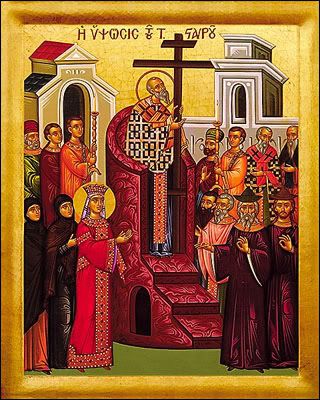
The feast of the elevation is in honor of the Cross of Christ. In remembrance of the suffering and death of Christ on the Cross, the day is one of strict fasting.
If the birth of the Holy Virgin is the anticipation of the mystery of the Incarnation, then the Cross announces the redemptive sacrifice of Christ. For this reason the feast is celebrated in the beginning of the Church calendar year (August 19/September 1).
The sign of the cross - in Roman times an instrument of shameful death, after Golgotha it became the symbol of salvation and victory.
Through suffering to joy, through death to victory, through sacrificial giving to fulfillment of God's will - such is the way of the Redeemer of the world, such is the way of His followers. "Whosoever will come after Me, let him deny himself, and take up his cross, and follow Me" (Mark 8:34). This is not just difficulties and suffering, which on their own do not become the Cross. "To take up your cross" is to reject your self, defeat love of self, learn to live for others, learn courage, patience, and to faithfully follow Christ.
The origin of this feast is found in the glorious reign of Constantine the Great (fourth century), who erected the church of the Resurrection on the sites where the Tomb and Golgotha were. This place had drawn Christian pilgrims from the very beginning of the existence of the Church. However, in the beginning of the second century, Emperor Hadrian, who was against both Judaism and Christianity, decided to destroy traces of both religions. He rebuilt and renamed Jerusalem, leveled Golgotha, filled in the Tomb and built a temple to Venus in its place. When the Emperor Constantine proclaimed Christianity a free religion, he, at the urging of his Christian mother, St. Helen, ordered the pagan temple to be destroyed and excavation on this holy site to be begun. Layer after layer was removed and all of a sudden in the depths of the earth, when all hope was gone, an empty space appeared and then the true and holy sign of our salvation. Writes a contemporary of the events, Eusebius: There in the ground three crosses were found - but the sign which had been placed on Christ's cross had fallen off, and it was impossible to decide which was His cross. Only after miracles occurred at one cross, such as the healing of a sick woman and the resurrection of one who was dead, did it become known which was the True Cross. Then crowds of people flocked to the place wishing to bow before the Life-giving Cross and started begging the Patriarch to raise it so all could see. The Patriarch stood on an elevated place and raised the Cross, and from this action comes the name for the feast.
On the site where the Cross was found, St. Helen built a church to the glory of the Resurrection of our Lord Jesus Christ, and the True Cross was kept in it. The main part of the Life-giving Cross is even at present kept in Jerusalem, in the Greek church. The other parts of it were carried all over the Christian world.
The hymns to this feast speak of the Cross that is raised above the world as "the beauty of the Church," as "the confirmation of the believers." The Cross is the sign of God's love for man, the harbinger of the coming transfiguration of nature.
Back to the feasts subsection
OFFSITE: Great Feasts of the Orthodox Church - Original article.
Back to the main page
OFFSITE: Uncut Mountain Supply - See the icon used on this page for sale.